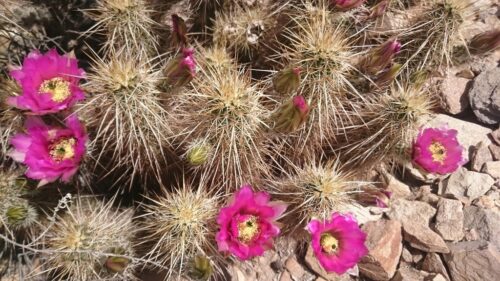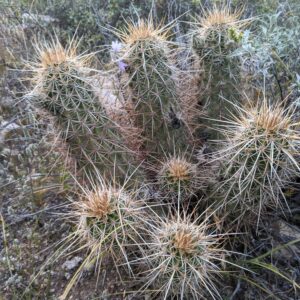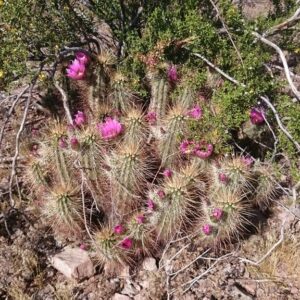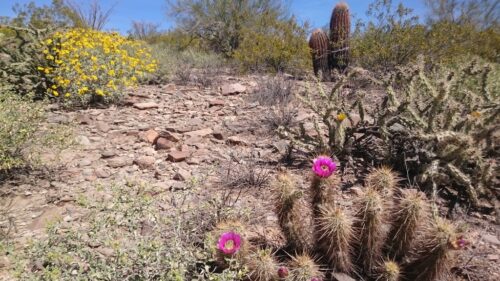Plant Profile: Engelmann’s Hedgehog Cactus
Posted Mar 30, 2021
Strawberries of the Desert
By Kathleen M. McCoy, Master Naturalist, AZNPS Phoenix Chapter Member
Many Echinocereus, including Engelmann’s hedgehog or Strawberry cactus (E. engelmannii), produce a very delicious fruit reported to taste a lot like strawberries (Eppel, 2012). The tiny red fruit, in keeping with the stature of the diminutive Engelmann’s hedgehog, comes from a 4 to 12 inch tall cylindrical cactus with 8 to 14 ribs. The inch-long fruit can be circular to egg-shaped with a fleshy white pulp. As the fruit reaches maturity, the deciduous spines fall off (Tibbits, 2020).
In contrast, its large 2 to 3 inch wide tubular flowers seem oversized. The brilliant flowers blossom from April to May ranging in color from bright magenta to pale pink, but only last for 5 days opening in the morning and closing at night.

Photo credit: Lisa Rivera
Native to the southwestern US and northern Mexico, this slow-growing succulent’s name is due to short, spiny stems which resemble hedgehogs. Their 2 inch curved radial spines may be red, yellow, white, or gray. Protection from rodents and other herbivores is provided by the sharp spines, sometimes covering the whole plant. The spines also give shade which keeps the stem at an optimal temperature. To reduce water loss, the cactus produces a waxy coat which is heaviest on the plant section receiving the most sun. In the evenings, Hedgehog cacti open their stomata (pores) to perform an oxygen and carbon dioxide exchange (Lady Bird Johnson Wildflower Center, 2010).

Photo credit: Lisa Rivera
Found on hillsides, desert plains, and scrubland in generally dry, sunny locations, this perennial appears from sea level to 5,000 feet. They form medium-sized clusters or colonies with as many as 50 to 60 stems and spread 3 feet wide. The stems of these very common cacti are initially upright but with old age may fall to the ground and grow laterally.

Photo credit: Lisa Rivera
At least 8 varieties of E. engelmannii are found in the Sonoran Desert and in garden nurseries as well. These pretty little succulents can be propagated from seeds sown in the spring or offsets grown from a base plant. To thrive, potted or wild, a Hedgehog cactus needs nearly full sun for 6 or more hours daily and good drainage (VanZile, 2021). Overwatering is likely to produce root rot. If potted, a small dose of diluted fertilizer once or twice a month will maintain a healthy plant.
As a food plant, hedgehog cacti have been used by indigenous peoples of the Southwest. Ripe fruit has been eaten raw and dried for future use, prepared as a sweet snack for children, and converted to a jam or jelly. The inner stem, described as a survival food, is best eaten boiled or roasted.
The Hedgehog cactus has additional properties valuable to desert dwellers and others. The soothing topical qualities of the inner stem can be applied to burns including sunburn. Taken internally, reports suggest that the inner stem also has potential to lower blood sugar and cholesterol levels (Kane, 2020). Other than the prickly thorns, no cautions exist for the fruit or stems. The biggest challenge presented by the Hedgehog cactus is to find the ripe fruit before the birds and rodents have a special strawberry-flavored treat!

Photo credit: Lisa Rivera
Sources:
Eppel, A. (2012). Plants of Arizona: A Field Guide. Rowan and Littlefield: Helena, Montana.
Kane, C.W. (2020). Sonoran Desert Food Plants. Lincoln Town Press: USA.
Lady Bird Johnson Wildflower Center. (2010). Echinocereus engelmannii. https://www.wildflower.org/plants/result.php?id_plant=ECEN
Tibbits, D. (2020). Hedgehog cactus information. SFGATE. https://homeguides.sfgate.com/hedgehog-cactus-information-43972.html
VanZile, J. (2021). How to grow Echinocereus cacti. The Spruce. https://www.thespruce.com/grow-echinocereus-cactus-indoors-1902978

